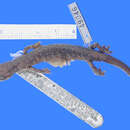Description
provided by AmphibiaWeb articles
Diagnosis: Bolitoglossa marmorea is a moderately sized salamander (adults range from 128 to 134 mm in total length; males measure 59-66 mm in standard length, while females are 60-72 mm in standard length; the tail is moderately long at 48-56% of total length) with long limbs and large, moderately webbed feet bearing subterminal pads. Maxillary teeth number 48-80; vomerine teeth number 22-38. Limb interval is 0-0.5 costal folds in males, 1.5-2.5 costal folds in females. Usually 13 costal grooves. It is purplish-brown with yellow flecking and small yellow spots. Similar to B. sooyorum morphologically but distinct molecularly (Savage 2002).First described by Tanner and Brame (1961). The species name marmorea refers to its marbled color pattern.A Spanish-language species account can be found at the website of Instituto Nacional de Biodiversidad (INBio) (http://darnis.inbio.ac.cr/FMPro?-DB=UBIpub.fp3&-lay=WebAll&-Format=/ubi/detail.html&-Op=bw&id=4337&-Find).
Tanner, W. W., and Brame, A. H. Jr. (1961). ''Description of a new species of salamander from Panamá.'' Great Basin Naturalist, 21, 23-26.
Distribution and Habitat
provided by AmphibiaWeb articles
Costa Rica and western Panama, on lower montane and montane slopes of the southern Cordillera de Talamanca-Barú, at 1,920-3,444 m asl. Collected from under rocks in the crater of Volcán Baru, western Panama (Tanner and Brame 1961). It is also associated with moss mats covering tree trunks and branches (Wake 1987).
Life History, Abundance, Activity, and Special Behaviors
provided by AmphibiaWeb articles
This species is arboreal and is active at night, climbing on mossy trunks and tree limbs (Wake et al. 1973; Savage 2002). It hides under rocks during the day (Savage 2002). Presumed to breed by direct development (Stuart et al. 2008).
Life History, Abundance, Activity, and Special Behaviors
provided by AmphibiaWeb articles
This species was thought to be common but has not been seen in nearly a decade. It can survive in degraded habitats, but severe habitat loss due to agricultural expansion and/or fire is a threat. It occurs in two protected areas: Parque Internacional La Amistad in Panama and Costa Rica, and Parque Nacional Volcán Barú in Panama. Survey work is needed (Stuart et al. 2008).
Crater salamander
provided by wikipedia EN
The crater salamander (Bolitoglossa marmorea), also known as the marbled crater salamander, is a species of salamander in the family Plethodontidae. It is endemic to Costa Rica and Panama. Its natural habitat is subtropical, high-altitude moist montane forests. It has a small area of distribution (less than 5000 km2 and fewer than five locations) and is threatened by habitat loss therein.
Appearance
The crater salamander is a moderately sized salamander. Adults of the species typically range from 128 to 134 millimeters. It is colored purplish-brown with small yellow spots and flecking across its body. The tail of this salamander composes approximately 48–56% of its total length.[2]
Habitat and ecology
The crater salamander is found in humid montane forest and is nocturnal, meaning it sleeps under rocks during the day and is found on mossy trunks and tree limbs at night.
It inhabits the lower montane and montane slopes of southern Cordillera de Talamanca of eastern Costa Rica and western Panama.
Conservation
Although endangered, the species does occur in two protected areas, Parque Nacional Volcán Barú in Panama and La Amistad International Park in Panama and Costa Rica. Although known to be common, it is decreasing and the current population status is unknown due to lack of survey work.
References

- license
- cc-by-sa-3.0
- copyright
- Wikipedia authors and editors
Crater salamander: Brief Summary
provided by wikipedia EN
The crater salamander (Bolitoglossa marmorea), also known as the marbled crater salamander, is a species of salamander in the family Plethodontidae. It is endemic to Costa Rica and Panama. Its natural habitat is subtropical, high-altitude moist montane forests. It has a small area of distribution (less than 5000 km2 and fewer than five locations) and is threatened by habitat loss therein.
- license
- cc-by-sa-3.0
- copyright
- Wikipedia authors and editors

